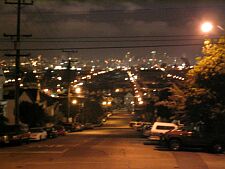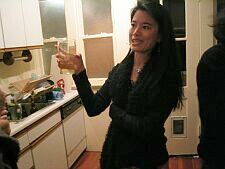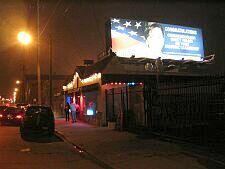17 January 2003
A little snow
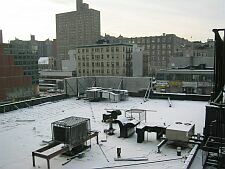
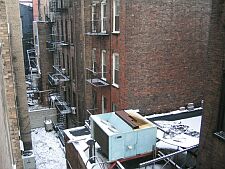
i just looked out the window and realized that it must have snowed last night. i was up most of the night, but didn't realize it until just now. and can it get any colder? right now its 23F/-5C (11F/-12C with wind chill). and its supposed to drop at night to 10F/-12C (0F/-18C with a similar breeze) over the next few days. yikes!!
Ugly Imperialism
talking about hawaii, on Jan. 17, 1893, "Hawaii's monarchy was overthrown as a group of businessmen and sugar planters forced Queen Liliuokalani to abdicate." another ugly chapter of american imperialism.
http://www.nytimes.com/learning/general/onthisday/big/0117.html
something new and exciting is percolating in the NYC art world
[went to see one of these exhibits with MOMAJA last month:]
http://www.paulwhkan.com/pqplus/archives/week_2002_12_15.html#000163
A Bread-Crumb Trail to the Spirit of the Times
By ROBERTA SMITH
http://www.nytimes.com/2003/01/17/arts/design/17SMIT.html
Connecting the dots formed by New York gallery exhibitions is a perpetual art world pastime. The process involves matching little details or broad stylistic trends, recognizing recurring themes and common materials, or sometimes just finding the shared thread in one's own seemingly unrelated reactions. And everybody comes up with a different diagram.
Right now there are interesting connections to be drawn from a handful of exhibitions spread around Manhattan, including some impressive solo debuts and a remarkable group show. Visiting them takes one through a progression of neighborhoods, architectural settings and ways of making and presenting art — to arrive, at least by my lights, at the suspicion that there is something new and exciting percolating beneath the surface of the art world of New York.
For one thing, there's something of a youthquake going on, with a rash of young artists interested, as most young people are, in the thrills and dilemmas of being young. For another, New York art is having a hands-on moment. While artists have always worked with their hands, right now those hands seem to be especially busy. Knitting, sewing and quilting have a raised profile; so do quirky, even craftlike ways of drawing and painting, and approaches to video that make the medium feel thoroughly worked over — touched, so to speak.
And the underground is everywhere. It is no longer the pride or bane of a few gentrification-ready neighborhoods. You can find new art on the Upper as well as the Lower East Side; in Chelsea, which is much less the homogenized blue-chip zone it is often thought to be, as well as in Harlem.
Of course, these developments are not entirely unrelated. They are, to stretch observation into metaphor, all signs of people taking things into their own hands, of a healthy autonomy. They have, for me, the atmosphere of 1970's pluralism and laissez-faire, but this time more fleshed out and purposeful. It is less a pervasive condition than a question of personal style, if not a philosophy. It may be perpetuated by artists' collectives or by individuals working in so many mediums that each artist could appear to be a one-person collective.
These artists are confidant, free of ideology and, despite being camera savvy and computer adept, transfixed by the physical possibilities of art-making. Using Photoshop doesn't mean you can't also knit. Taking up a video camera doesn't mean you can't wield it like a paintbrush, or edit with the precision of a jeweler. Several of these shows may remind you that the children of the original flower children are becoming artists.
After all, boiled down to its essence, craft is simply concentration and care made manifest. It is materialized love, which partly explains the sincerity found in much of the new art that's around today.
Craft is also an effective way for young artists to reclaim pop culture: a direct grass-roots effort to subvert and reshape the stuff they have been force-fed from an early age.
Kenny Schachter Contemporary
The place to begin this tour, because it provides the most undiluted glimpse of youth-crazed craft and love, is "Air Show," the tour-de-force debut of Misaki Kawai at Kenny Schachter Contemporary, a gallery on an old alley in the West Village that is straight out of "Gangs of New York."
Ms. Kawai, who is 24 and lives in Tokyo, gives new meaning to the word aircraft with a fleet of elaborately handmade airplanes, accompanied by puffy cotton jet trails and blue felt clouds. The latter are sewn to the angled steel-mesh walls of the gallery, whose intimist (read: tiny) industrial interior was designed by the Acconci Studio.
Suspended in midair, Ms. Kawai's fleet ranges from a large airliner to fighter jets and biplanes, all stitched together from assorted fabrics — underwear, baby blankets, flannel pajamas — that remind you that patchwork is among the oldest forms of appropriation. Ms. Kawai has the funky exquisiteness of the classic dollhouse vernacular down cold, from tiny pillows and emergency instructions to busy flight attendants and imaginatively attired, werewolf-wigged passengers (their faces are all photographs of Beatles) who are reading, tending computers and, in one case, drawing.
She may be indebted to that master of miniaturization Charles LeDray, but she could also be the 21st century's version of Ettie Stettheimer, the dollhouse-building sister of the self-taught painter Florine Stettheimer, who was also one of the great art salonistes of 1920's New York.
While in the vicinity, some side excursions can provide further evidence of craft's current prominence and recent history in art: "Cheap," a group show at White Columns; Tom Sachs's miniature city at the Bohen Foundation; and, at Elizabeth Dee in lower Chelsea, Kevin Landers's latest excursion into handmade social commentary, which includes a plastic-putty-and-fabric re-creation of the wall of Nike sneakers made famous by Andreas Gursky's panoramic photograph.
John Connelly Presents
An equally significant stop is "K48: Teenage Rebel: The Bedroom Show," Scott Hug's ode to the chief laboratory of adolescent fantasy and subversiveness. John Connelly Presents, a young Chelsea gallery, occupies a small perch in a huge building that is an art-world microcosm. Tenants include galleries at all levels of economic viability, dozens of artist studios, the odd hip magazine (Index) and now a health club. A glance at the extensive lobby directory can induce social fatigue.
Mr. Hug's show is a delight. Packed into one room is a collage of works by a total of 70 artists, designers and collectives that is at once a finger-on-the-pulse survey and a personal manifesto, almost a solo show. A live-in environment where visitors can watch videos, listen to music and sift through bureau drawers, the show is, additionally, the walk-in equivalent of K48, the sharp-looking yet oddly homey magazine of art, fashion, music, design (and sex), now in its third issue, that Mr. Hug publishes.
The mix is beyond ecumenical. The displays include, for example, Claire Corey's Richter-esque digital abstraction as well as distinctive patchwork T-shirts by the collective Dearraindrop, whose members also contribute similarly bristling collage paintings, and the antic drawing-photocopy-cartoon collages of Billy Grant.
The feverish interaction of art, popular culture, craft, graphic design, film and music is everywhere apparent, and richly informative, both artistically and sociologically. But what makes it pop visually is Eli Sudbrack's wallpaper, mostly red, with its sweet, savvy fusion of psychedelic poster, Kate Greenaway and Renaissance tapestry.
And that Mr. Hug is living in the middle of all this makes his show the latest addition to the tradition of the fully furnished, mostly functional installations by Lucas Samaras, Ben, Chris Burden, Andrea Zittel, RirkritTiravanija and, most recently, Marina Abramovic.
While in the building, you can see more craft consciousness at Greene Naftali, in the abstract paintings of Sergej Jensen, a 29-year-old Danish artist living in Germany, who prefers glued-on pieces of denim and leather and occasional daubs of bleach to paint; and at Rush Arts, which is showing pieced-together garments by Gerald Jackson.
Daniel Reich
Another excellent visual adventure is "Life Is a Gift," Christian Holstad's first gallery show. The work centers on a plastic-enclosed bedroom that is a tribute to outsiderness in the form of a homage to David Vetter, the "bubble boy" whose defective immune system sentenced him to a brief, 12-year life of physical isolation in a germ-free plastic bubble. The show fills the small studio-apartment gallery of Daniel Reich, who sleeps in the piece each night (and is in the unusual position of not having to roll up his mattress each morning before he starts work).
Mr. Holstad is a one-artist collective, equally at ease with knitting, quilting, collage, drawing and sculpture; his work has a multimedia mix that mirrors Mr. Hug's effort at Connelly. But it also clarifies much that is merely glimpsed in the rich loam that Mr. Hug has brought together, especially the penchant for obsessive, half-invented techniques that often yield small-scale but concentrated results shot through with a fervent mysticism.
Everything in this show refers to the bubble boy, more or less directly. An exquisite color-pencil rendering of a garden includes a pair of big rubber gloves like the ones built into the bubble's interior to enable David's parents to hug him. Graphite-toned drawings made from newspaper photographs, which are erased and configured into little Symbolist dramas, touch repeatedly on the theme of freakishness and difference.
Perhaps the most characteristic of Mr. Holstad's odd fusions of innocence and subversiveness are pornographic collages whose coupled figures — "bubble boys" who have found each other — are layered with photographic patterns that turn out to be bits of hand-knit afghans cut from the pages of magazines.
Other signs of Mr. Holstad's ecumenism include a quilt, a strange wool-knit tree branch that culminates in a skull made of rubber foam and a removable quilted deer's head, and a trompe l'oeil rag rug carefully pieced together from faux-carpet linoleum.
Oliver Kamm/Apartment 5-BE
A sign of the Chelsea underground is the gallery that Oliver Kamm, who formerly worked at Marianne Boesky and Paul Morris, has opened in his one-bedroom apartment on West 23rd Street. For his second show, he is presenting the New York debut of Colin McClain, a young artist from Tennessee who derives his motifs from Gray's Anatomy.
Mr. McClain's oil paintings of figures and torsos are the work of a developing artist. But his slightly skitterish drip technique, and his brash palette of pinks, greens and yellows, supposedly inspired by skateboard graphics, give the human form a neon vibrancy.
In many ways the blunt force and homogeneity of this show, and its images of totally exposed bodies, may be the perfect chaser to the air of haunted fragility and its wild range of emotions and materials that dominate Mr. Holstad's show.
Triple Candie
"Sugar & Cream," a modestly ravishing excursion into the recent history of quilts, banners, flags and embroideries, looks great in the big white space of Triple Candie, a scrappy Harlem alternative space. The show underscores that such techniques have been around for a while, even if exhibitions like "The Quilts of Gee's Bend" at the Whitney Museum of American Art have given them a new visibility. Nearly everything here points up the flexibility of so-called craft mediums.
The outer limits are defined by David Hammons's "African-American Flag," Dinh Q. Le's black-on-black embroidery, James Hyde's formalist webbing-paintings and Oliver Herring's 1993-94 "Curtain," an immense swath of knit transparent tape that is aging beautifully.
Honing closer to traditional craft are the the quilts and quasi-quilts of Tracey Emins, Rosie Lee Tompkins and Trenton Doyle Hancock, whose paint and felt "Torpedo Boy's Chest Mess" is especially good. Caught in the crossfire between these works is a kind of quilt ghost: Jim Hodges's big, fluttery "Here's Where We Shall Stay," a semi-transparent expanse of sewn-together chiffon head scarves.
This show should inspire a larger, more inclusive effort, which might also encompass Faith Ringgold, who has three new painting-quilts at the ACA Gallery in Chelsea; Mike Kelley, whose "All the Love Hours" at the Whitney is looking more and more like a generational touchstone; Thomas Lanigan-Schmidt with his cellophane-embellished altarpieces; and maybe even Lari Pittman, whose paintings bring suggestions of graphic design, illustration, embroidery and textile design into a fruitful alignment.
Down the street from Triple Candie, the Project is showing "Pink Slips and Golden Parachutes," a lively show of work by past and present employees of the gallery. It includes "We Are Left," a large mural-size expanse of embroidered organdy, by Jessica Rankin. While indebted to artists like Julie Mehretu and Matthew Ritchie, this work has a casual finesse and compositional intelligence all its own.
Salon 94
If anyone needed confirmation that the underground can bubble up anywhere, look no further than East 94th Street and Salon 94, perhaps the poshest project space ever to sashay into any art scene. Established by Jeanne Greenberg Rohatyn, a partner in the Artemis Greenberg Van Doren Gallery, on Fifth Avenue just off 57th Street, Salon 94 is a semiprivate showcase for young artists.
Its setting is the ground floor of a former orphanage between Madison and Fifth Avenues that has been extensively redesigned by Rafael Viñoly with a curving glass wall and burl staircase, and stylishly decorated by his wife, Diana Viñoly. It could position Ms. Greenberg Rohatyn, who lives on the building's upper floors with her family, as a contemporary Peggy Guggenheim, a collector and dealer of means with an eagle eye for the latest thing.
The gallery's outstanding inaugural show manages to withstand all the built-in glamour. It introduces the percussive, narratively complex videos of Aida Ruilova, which are fraught with an air of slightly muffled domestic hysteria. As it happens, Ms. Ruilova also has an ultrarefined drawing of wolf-eyed figures in Mr. Hug's show at Connelly, and that rendering is consistent with the needle-sharp precision she brings to video editing.
Working with tapes of friends as they creep about decaying houses, peer through windows, hang from rafters and dart up staircases, Ms. Ruilova slices and dices their gestures and sounds with a D.J.'s sense of economy and rhythm, creating a cast of young shut-ins, stuttering eccentrics and assorted sociopaths. Shown at intervals on small screens or monitors, the videos' sounds play off one another to eerie effect.
In "Come Here," the title is repeatedly hissed by a young man in the shade of a large potted plant who seems to be summoning a zombie version of himself. "Almost" is the strangled message from a disheveled girl who crawls up (or down?) a rickety staircase and picks at a crumbling plaster wall. A sense of gothic foreboding and obsession that doesn't preclude comedy infuses the images, which recall some of Anna Gaskell's photographs. Their haunting snippets of sound and image force an extraordinary concentration; they remain mysterious even while they are drummed into the mind.
Maccarone
If Ms. Ruilova patches together videotape with a jeweler's sensitivity to nuance and facets, the young California artist Anthony Burdin, who is making his debut at Maccarone on the Lower East Side, begins by wielding the camera like a trowel. And while Ms. Ruilova's single drawing at Connelly has a silverpoint fineness, Mr. Burdin's works on paper, with titles like "Witchy Forecast" and "Legendary Ghost Scrawl," vibrate with a jittery paranoia to the verge of disintegration. Their out-of-focus, speaking-in-tongues wildness brings to mind H. C. Westermann, or the lettering on a goth teenager's notebook. They would be even more at home in Mr. Hug's installation.
Mr. Burdin's extraordinary show liberates youthful reverie from the bedroom and takes it on the road. With the camera and a boombox as his constant companions, he seems to spend a great deal of time creating raw material. This means playing rock on the boombox (for the videos in this show, it was all Blue Oyster Cult all the time) while waving the camera all over the place, sometimes singing along with the music as he goes.
He assumes two personas. As Voodoo Vocal, he views Los Angeles from behind the wheel of his ancient funky car, which functions as both a sound studio on wheels and a private performance stage. As Desert Mix, he beomes a kind of rogue D.J., dragging the boombox through fields of brush and wildflowers, muttering, growling and drooling from behind the camera.
Once these tapes are made, Mr. Burdin assiduously reworks them in the computer. Unlike Ms. Ruilova's work, his involves no cutting, just distortions and manipulations of sound and image until he achieves a satisfactory degree of hallucinatory spookiness or semiabstractness. The country videos, with their off-camera portrait of the artist as shaman or Abominable Snowman, are less effective: they have the feeling of a "Saturday Night Live" skit with no punch line.
But in the Voodoo Vocal tapes, magic happens. The street lamps and traffic lights are transformed into swarms of hovering diamond-shaped spaceships, rain on the windshield can resemble fields of diamonds, and the sound pulses around us. Melding imagination, lived experience and video into a fresh combination, Mr. Burdin leaves no doubt about his hands-on involvement with his medium. He is in tune with his time.
16 January 2003
Walk down lower Orchard
took a walk down lower orchard last evening. past 75-79 Orchard where 25yr old Burke O'Brien was shot dead. a quiet presumably safe few blocks. galleries, wholesale and discount clothing stores, a cyber cafe, and kids walking home from school.
more news. but i'd like to believe it was not just a random robbery. something just doesn't add up.
http://www.nytimes.com/2003/01/15/nyregion/15MURD.html
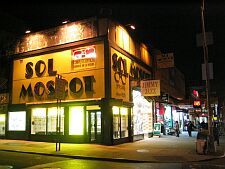
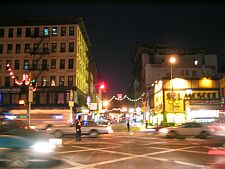
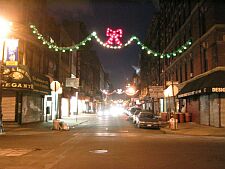
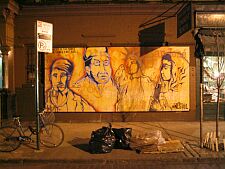
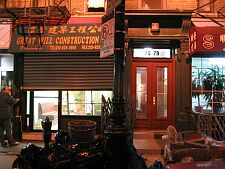
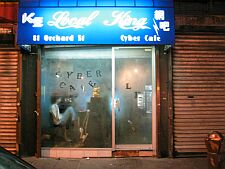
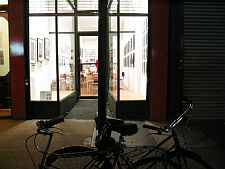
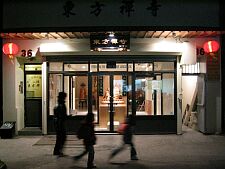
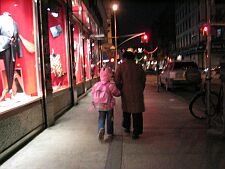
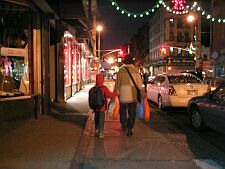
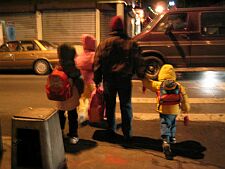
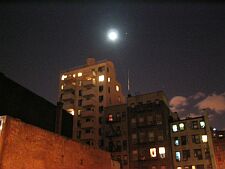
Third Witness Bolsters Robbery Theory
Witness Bolsters Robbery Theory in Lower East Side Murder
By MARC SANTORA
http://www.nytimes.com/2003/01/15/nyregion/15MURD.html
As the police sorted through two competing theories about who killed a 25-year-old man on the Lower East Side on Sunday, a third witness emerged whose account suggested that the victim, Burke O'Brien, was killed by robbers, the police said yesterday.
Her statement contradicts two earlier accounts, investigators said. One man who came forward said he was about 25 yards away and saw two men, not four, according to investigators. The witness did not see a gun, but he said one of the men — who wore a striped hat of a type that investigators say Mr. Bloede was wearing — had outstretched his arm in a manner that he took to be the pointing of one. The witness told investigators he then heard a shot and saw the other man collapse, the investigators said. The other earlier account corroborated that one.
Investigators said they were still evaluating evidence in the shooting of Mr. O'Brien, a Chicago native who had just come to New York to begin work at the Bank of America.
The police had briefly charged Forrest Bloede, a college acquaintance of Mr. Burke's with whom he was staying, on the basis of two eyewitness accounts. But the charge against Mr. Bloede (pronounced BLO-dee) was dropped after investigators determined those statements were insufficient and there was no credible motive for Mr. Bloede to kill Mr. Burke.
Police officials had also said that a test of Mr. Bloede's jacket indicated that it was unlikely that he had fired a weapon. But yesterday, they said there had been a miscommunication among officials: the tests have not yet been conducted.
The third witness came forward Monday afternoon. She told investigators she saw a group of as many as five people outside the apartment building at 75-79 Orchard Street, between Grand and Broome Streets, at the time of the shooting. That would support Mr. Bloede's account that two robbers shot Mr. O'Brien. While the new witness, a lawyer who was walking on the block, was not able to describe the people she saw, she said some looked menacing enough that she ran away, investigators said. Then she heard a gunshot.
Her statement contradicts two earlier accounts, investigators said. One man who came forward said he was about 25 yards away and saw two men, not four, according to investigators. The witness did not see a gun, but he said one of the men — who wore a striped hat of a type that investigators say Mr. Bloede was wearing — had outstretched his arm in a manner that he took to be the pointing of one. The witness told investigators he then heard a shot and saw the other man collapse, the investigators said. The other earlier account corroborated that one.
TWILIGHT IN THE RIVER PAVILION
TWILIGHT IN THE RIVER PAVILION
by Chiang She Ch'uan (1725-1784)
translated by Kenneth Rexroth
I lean on my rustic gate
Above the swift river
In the evening and hear
The distant sound of women
Beating clothes. The little bridge
Arches over the fishes
And turtles. Once in a great while
Someone crosses. A reflection
Appears on the water, then is gone.
15 January 2003
Back in cold NYC
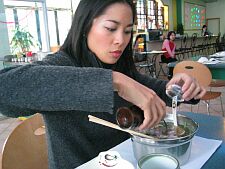
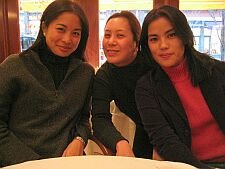
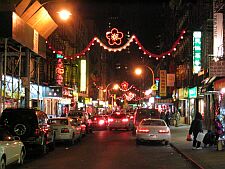
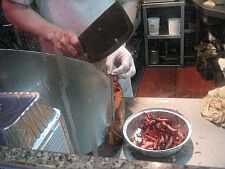
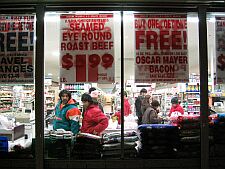
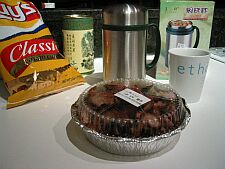
well, finally back in NYC, and it is soooo cold! so immediately went for shabu shabu, and bought a cool aluminum thermos in chinatown to keep my tea hot. with 20 foot ceilings in our living room, i'm afraid to see what our heating bill will be this month.
and talking about scary, at 4am monday morning, just a few hours after i came back from SF, a young banker was shot dead just two blocks south of where i live on orchard!! doesn't sound like a random killing though. but we'll have to see.
http://www.nytimes.com/2003/01/14/nyregion/14MURD.html
http://www.nytimes.com/2003/01/13/nyregion/13SLAY.html
in any case, have to fight the cold and get back to work. i'm still on hawaii time, and wishing i were there. posted more pictures from our last week there, and a quick stop in san fran to see some college friends.
http://www.paulwhkan.com/pqplus/archives/cat_blog.html
have a long list of articles to post. but will have to get to them later...
LES Murder Plot Thickens
Friend Arrested in Murder, Then Charge Is Dropped
By ROBERT D. McFADDEN
http://www.nytimes.com/2003/01/14/nyregion/14MURD.html
Mystery surrounding the weekend killing of a newly arrived young banker on the Lower East Side deepened yesterday after the police filed a murder charge against a college acquaintance who was with the victim when he was shot, but then dropped the charge and released the man at the request of the Manhattan district attorney.
As relatives and friends from Illinois and Pennsylvania gathered in New York to mourn the slain man, Burke O'Brien, 25, investigators said that a swirl of evidence suggested two seemingly plausible but mutually incompatible theories of the killing: a robbery by strangers, or a dispute between the acquaintances.
Mr. O'Brien, a Chicago native and a Colorado State University graduate who arrived in New York last week to begin work for the Bank of America, was shot in the chest about 4 a.m. Sunday outside 75-79 Orchard Street, between Grand and Broome Streets, where he and his sister, Raurie, were spending the weekend with three friends, including Forrest Bloede, a college fraternity brother.
In a statement to the police, Mr. Bloede, 24, said that after a night at clubs, the five had taken two cabs back to Orchard Street. He said he and Mr. O'Brien, in one cab, had arrived after the others about 3:50 a.m., but lacking money for the driver, they stopped at a Fleet Bank automated teller machine at Orchard and Grand.
They took out $20 — the A.T.M. recorded the withdrawal at 3:53 a.m. — paid the cabby and walked to Mr. Bloede's building half a block away, he said. As they neared the door, he said, two black men, one with a gun, accosted them. He said he gave them the change from the $20. But he said Mr. O'Brien, reacting to the encounter, took off his coat, tried to get the money back and was shot.
Mr. Bloede said that the robbers fled and that he ran inside to get help from Mr. O'Brien's sister and friends, and to call the police. He said he and others called 911. The police recorded several calls at 4 a.m. from people who said the shot had been fired only a minute or two earlier.
But investigators said that a witness, a man who had just left a bar and who was on Orchard Street 25 yards away, had not seen a robbery as recounted by Mr. Bloede, but had seen only two men in a confrontation, one of them wearing a distinctively striped ski hat, like one the police said Mr. Bloede was wearing.
The witness said he saw the two men standing face to face and that one of them — the one with the ski hat — appeared to have a gun. The witness said he saw the other man — presumably Mr. O'Brien — put his hands up in the air. Then he heard a gunshot and saw the victim collapse on the sidewalk.
The man in the ski hat then picked up the victim's jacket, which was on the sidewalk, and draped it over the fallen man, the witness told investigators. He said the man then ran into the building. The investigators said that a second witness saw the shooting, but from a much greater distance.
While the police were unable to find anyone else who saw the shooting, they said others who live on the block had reported hearing what sounded like a loud, drunken argument on the street moments before the shot was fired. Some looked out their windows, but none reported seeing or hearing a robbery or robbers fleeing the scene.
After interviewing the witnesses and consulting with an assistant district attorney on Sunday, the police charged Mr. Bloede at 12:30 a.m. yesterday at the Seventh Precinct station house with second-degree murder, which is punishable by 25 years to life in prison.
Later yesterday, the authorities began to have second thoughts. While a .45-caliber shell casing had been found on the sidewalk near the body, a search of Orchard Street and of Mr. Bloede's building and apartment failed to find a gun. City workers also checked the sewers around the building but did not find a gun, detectives said.
Gunpowder residue, usually a sign of proximity to a recent gunshot, was found on Mr. Bloede's jacket, but a senior investigator said that the traces were fainter than would be expected if he had fired the gun. It was thus possible that Mr. Bloede could have been near someone else who fired the fatal shot.
Investigators, seeking a motive, indicated that they had questioned friends of Mr. O'Brien and Mr. Bloede about a possible romantic rivalry over a young woman who had been with them on Saturday night as they went to a Bleecker Street club, the Elbow Room, to hear a band called M-Lab, and later to a West Village diner called the Dragon Fly.
But Mr. O'Brien's family said that the woman was just a friend and that he had not been romantically involved with her. A member of M-Lab, a close friend of Mr. O'Brien's, said that there had been drinking, but that Mr. O'Brien and his friends were not drunk and that there had been no signs of a dispute between Mr. O'Brien and Mr. Bloede.
"I've gone over the night a thousand times," the friend said. "and there is nothing — nothing that seemed out of the ordinary. No fights. Nothing like that. There was no sign of animosity whatsoever. There was nothing but a bond of friendship between those two."
About 12 hours after Mr. Bloede's arrest, the murder charge against him was dropped and he was released. "Pending further investigation, the district attorney's office has declined to prosecute at this time," Barbara Thompson, speaking for the Manhattan district attorney, Robert M. Morgenthau, said in a statement. There was no elaboration.
A New York lawyer representing Mr. Bloede, Glenn A. Wolther, declined to comment on the filing and withdrawal of charges, but said Mr. Bloede was "deeply saddened and distraught at the death of his friend, and will continue to cooperate with authorities on the matter."
Mr. Bloede, who has no criminal record, has shared his $1,800-a-month, ground-floor, two-bedroom apartment on Orchard Street since last fall with a roommate, who had joined the Saturday night out. He is a grandson of Victor G. Bloede, who was the chairman and chief executive of the Benton & Bowles advertising agency for many years until his retirement in 1983. He died in 1999. Among his legacies were the Maxwell House Coffee slogan "Good to the last drop" and Procter & Gamble's toilet tissue line "Please don't squeeze the Charmin."
Forrest Bloede grew up in Dallas, where he was a gymnast at Highland Park High School. Like Mr. O'Brien, he was a business major at Colorado State University at Fort Collins and graduated in 2001. Interviews on campus yesterday indicated that they were members of the Sigma Alpha Epsilon fraternity at the same time for about a year, but were not close friends.
Mr. O'Brien took a year off college to teach English in Ecuador, and later spent six months living in Australia. He had been living recently with grandparents in the Washington area. But last week, after being hired for a job as a currency trader with the Bank of America, he had come to New York to find an apartment and begin a business career.
Members of Mr. O'Brien's family were staying at a Manhattan hotel, and intended to take his body to the Chicago area for a funeral and burial. Speaking for the family, Mark O'Brien, the victim's father, praised the police but did not comment on the substance of the case.
"All of us in the family just do not understand how this could have happened," he said. "I am as confused about the nature of this as I can be."
Man Starting Career in City Is Slain on Lower East Side
Man Starting Career in City Is Slain on Lower East Side
By ROBERT D. McFADDEN and MARC SANTORA
http://www.nytimes.com/2003/01/13/nyregion/13SLAY.html
A 25-year-old man who arrived in New York last week to begin a career in banking was shot to death by an unknown killer early yesterday as he returned from an evening out to an apartment building on the Lower East Side where he had been staying with his sister and friends, the police said.
Investigators said the victim, Burke O'Brien, had stepped out of a cab with a male friend at 4 a.m. and was inserting his key in the entry lock of the six-story walkup at 75-79 Orchard Street, between Grand and Broome Streets, when the assailant shot him once in the chest and fled.
As Mr. O'Brien collapsed on the sidewalk, the police said, the friend ran inside to the ground-floor apartment where Mr. O'Brien had been staying, shrieking for help. The victim's sister, Raurie O'Brien, 24, ran out and tried cardiopulmonary resuscitation for six minutes until an ambulance arrived.
Jennifer Howell, 24, who lives in a second-floor apartment overlooking the scene, said she was awakened by the crack of the shot, looked out and saw the victim lying face up under the light of a street lamp. There was a woman kneeling to administer CPR and a man was standing by, she said.
"They kept saying they couldn't find the bullet hole," Ms. Howell said, and it was not until paramedics opened Mr. O'Brien's jacket and shirt that they found the small hole in his chest. Ms. Howell said she also observed a police officer with a flashlight who found a shell casing eight feet from the body.
Mr. O'Brien — a Chicago native and a graduate of Colorado State College who had lived in Ecuador and Australia and was to have begun work with the Bank of America in New York shortly — was taken to New York University Downtown Hospital but was pronounced dead on arrival, the police said.
"My son was a wonderful person," Barbara Burke, of York, Pa., the victim's mother, sobbed in the late afternoon darkness after she and the victim's uncle, Doug O'Brien, of Chicago, knelt to pray where her son had been shot. "All we know is we lost the best kid in the world."
Much about the killing — the worst nightmare of every family whose son or daughter has ever come to New York with dreams of success — was unclear last night. No description of the assailant was issued immediately and the police said they were examining various possible motives, including attempted robbery, although it was unclear if anything was taken from the victim.
As the investigation got under way, Burke O'Brien's parents and other relatives converged on Manhattan from Illinois and Pennsylvania, and amid the expressions of grief, a portrait of the young man began to emerge. By all accounts, he had been intelligent and ambitious, an athlete and an outdoorsman with a taste for travel and adventure.
"He played hockey in high school, he did every sport," Doug O'Brien said of his nephew. "At one point, he thought about being a Navy officer." He said Burke had also been a camping counselor for an organization that took city children on trips to Canada, where he taught them canoeing and camping skills.
Because of his love of the outdoors, Mr. O'Brien said, Burke decided to attend Colorado State College, in Fort Collins. He said his nephew majored in finance and business, but after graduating in May 2001, he went to Ecuador for a year and taught English. The young man then spent six months in Australia, Mr. O'Brien said, and had recently been living with grandparents in the Washington area.
Recently, Mr. O'Brien said, his nephew's application for a job with the Bank of America had been accepted, and he arrived early last week. "He came to New York to put his footprint on it," Mr. O'Brien said. "His aspirations were bigger than anything, than anyone's. He lived to tackle the big guy. You don't come to New York to become a peon."
Until he could find an apartment of his own, his mother and uncle said, Burke O'Brien moved in with his sister, with whom he had always had a close relationship, and with two friends of hers in Apartment 3, on the ground floor of the brown brick building on Orchard Street.
The street retains much of its historical look as a residential-commercial spine of the Lower East Side, where generations of East European Jews settled and thrived. The five- and six-story walkups still have fire escapes in the front. But the teeming crowds and pushcarts piled with shmattes are gone, and trendy boutiques, clubs and cafes have opened among the shops selling clothing, furniture and other merchandise.
Burke O'Brien, his sister and several friends went out on Saturday night to hear a band, investigators said. They arrived home about 4 a.m., apparently in separate cabs because Ms. O'Brien was already inside when the taxi carrying her brother and the second man drew up.
"They got out of a cab and someone shot him," Ms. Burke said as tears fell on her black coat.
"He was approached at the door as he was putting his key into it, and then he was shot," Doug O'Brien said. "There is no reason for this," he added, looking with an anguished face at the spot where his nephew had fallen. "Can you imagine?"
Referring to the time that elapsed as Ms. O'Brien was administering CPR, he said: "In six minutes, 24 hours happened."
Less than an hour after Mr. O'Brien died, his parents were notified by the police. His father, Mark O'Brien, flew in from Chicago and went to the scene but did not speak to reporters. Ms. Burke, who is divorced from Mr. O'Brien, drove in from York, Pa., so hurriedly that she did not pack a bag.
Doug O'Brien, who had accompanied his brother from Chicago, leaned on one of the metal railings flanking the single step under the double-door entry where his nephew had been killed. He shook his head again and again, as if in denial. "Great will!" he was heard to mutter. "Great will!"
It seemed to be a reference to his nephew's determination, but it was also the name of the business next to the crime scene: the Great Will Construction Company, painted on the glass in English and Chinese.
A resident of the apartment building, Joanna Bochner, 23, said she had just moved in over the weekend, leaving a place on the Upper East Side for what she called "a nice apartment with a nice roommate at a nice rent." She said she too, had been out on Saturday night and had arrived home at 5:30 a.m. yesterday to find her building cordoned off with police tape and aswarm with officers. "It's not very reassuring," she said of the murder on her doorstep. "It's kind of scary." But, she added, she had no intention of moving out.
13 January 2003
A Sunday in San Francisco
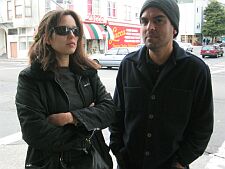
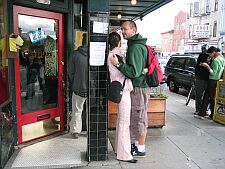
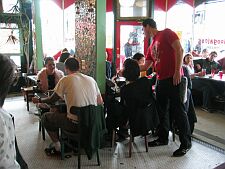
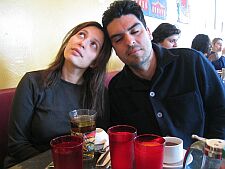




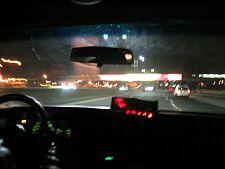
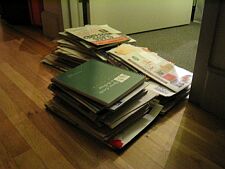
12 January 2003
A Saturday in San Francisco
saturday, spent the day walking around a few SF neighborhoods with my friend Rich, the arbiter of style. checked out the anime DVDs in Japantown, but the prices there ($25+) were pretty steep compared to NYC chinatown prices ($10+).
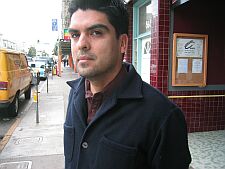
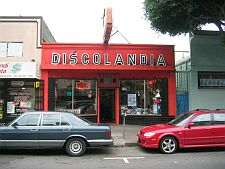
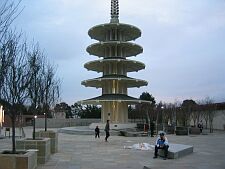
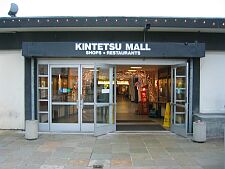
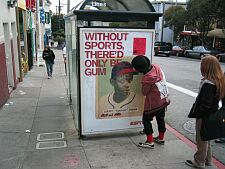
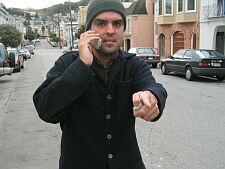
in the evening, we went to a party by some of Rich and Anna's Adams House (harvard) friends. as soon as we walked in, i saw a friend from school that i haven't seen in years! such a small world. after an evening of interesting discussions we headed to Sno-Drift to check out the scene. Nancy Pelosi (on a huge lighted billboard) kept watch.
